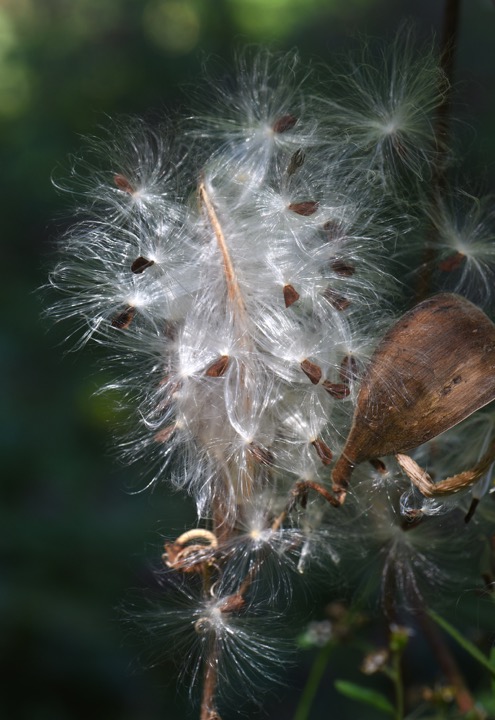Ask the Gardener: Butterfly weed, tomato seeds, rose bushes and more
Posted on: October 12, 2018 | Written By: Doug Oster |
Gardening editor Doug Oster gets asked a lot of questions. A lot. And he doesn’t mind offering gardening advice. But rather than just limiting those answers to the person who asked, we thought it might be a good idea to share that wealth of knowledge with everybody.
There are three ways to send in your questions:
- Email askdoug@535mediallc.com
- Submit your question on our “Your Garden” section of our site
- Send us a message on Facebook.
(The questions may be lightly edited for grammar/clarity/etc.)

Question 1: Butterfly weed
Lyman: I am harvesting seeds from the butterfly weed plant (asclepias tuberosa) and was wondering if there are any special things I need to do to prepare the seeds for planting next spring (such as storing them in a cold environment to break dormancy)? Any tips you have for giving the seeds the best chance to propagate would be greatly appreciated!
Doug: The seeds will need to be stratified if saved and then sowed in the spring. Put them in a sealed container and store them in the fridge for two months before planting. Another way to get them to sprout would be to plant them right away in a bed and let nature do the work. Then they will sprout when they are ready in the spring. You might want to try both ways to see which one works best.
Question 2: Tomato seeds
Mary Ann: To save seeds from a special tomato, do I need to let the tomato rot?
Doug: It needs to be a little overripe to be sure the seeds are mature. One thing to note, if the tomato is a hybrid variety, it won’t grow true. The seed will either be sterile or revert to one of the parents used in the breeding process. It can be interesting to see what happens, but it’s not the same tomato. If it’s a hybrid variety, that is always on the seed packet. The other type of tomatoes are open pollinated. Those seeds will grow the same type of tomato.
Squeeze the seed into a glass of water. Stir it once or twice a day for two or three days. This starts a fermentation process that removes the gelatinous coating on the seed and kills some diseases. I like to dry mine on coffee filters as the seeds don’t stick to them. Store the seeds in an airtight container to keep them dry.
Question 3: Winterizing rose bushes
Bobbie: How do I winterize rose bushes? Do I trim and then cover them somehow?
Doug: Any deadwood can be cut off now, but the major pruning will be done in April. Once the ground freezes, a light coating of mulch at the base will act as a blanket for the roots. Just make sure the mulch doesn’t touch the trunk of the plant.
Question 4: Winter rye
Josie: Can I plant winter rye in raised beds and if so, how can I prepare the beds in spring?
Doug: Yes, the winter rye is called a cover crop. It will hold the good soil in place, provide a habitat for beneficial insects and green manure in the spring. Cut down the foliage in the spring and leave it as a mulch for plants or turn it under. Remember though, the sheared plants stop seeds from sprouting, so put in plants.
Question 5: Garlic
Becky: Can garlic be planted in a 4x8x2 foot raised bed and survive winter and grow? Or do I need to plant it in the ground.
Doug: That will work. The key will be giving the cloves a thick layer of straw. Six inches or more. Over the winter it will flatten down. If you even wanted to cover the whole bed after mulching with a floating row cover, that would even keep the bulbs warmer over the winter.
Previous mailbags
Roses, Japanese beetles, planting garlic and more
Artillery fungus, heliotropes, crown gall and more
Skunks, pawpaws and a memorial tree
Mushrooms, harlequin bugs, fall planting and more
Beautyberry, nematodes, tomatoes and more
Pokeweed, bug identification and voles/moles
Caterpillars, mystery flower, onions and more
Seeds, leaf gall, bulb sale and more
Praying mantis, tomato issues, crabgrass and shrubs
Dogwood relocation, tomato issues and garlic soup recipe
Canada thistle, compost, bolting parsley and more
Blossom end rot, bees, butterfly weeds and more
Mystery bugs, lavender plants and watermelons
Strawberry plants, cool-weather crops, pumpkins and more
Tomato issues, zucchini struggles, lilacs and more
Hosta seeds, garlic, Alternaria leaf blight and more
Moving a hydrangea, hibiscus and succulents
Lilies, Brussels sprouts and septoria leaf spot
Garlic harvest, cucumber beetles, spindly tomatoes and more
Bladdernut, fungus gnats, rose black spot and more
Poison ivy, black-eyed Susans and container mix
Cucumber beetles, hot pepper plants and planting potatoes
Zebra grass, pale vegetables and yellow nutsedge
More from Everybody Gardens
See also, Compost Is The Building Block Of All Gardens And The Best Way To Recycle